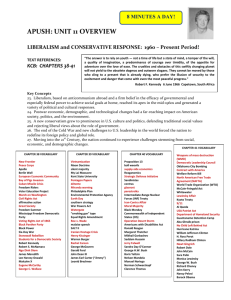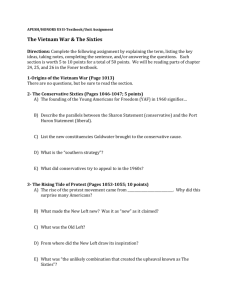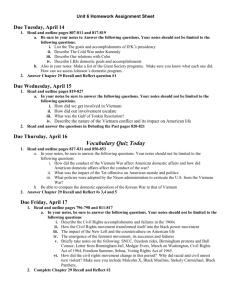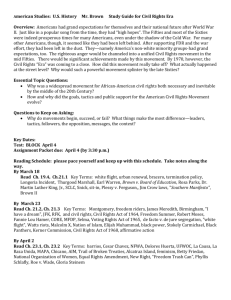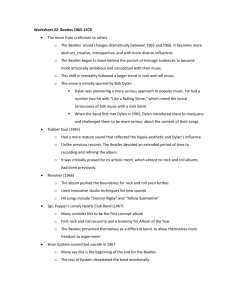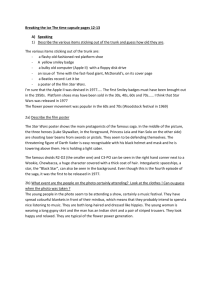Paradigm Shift Analysis
advertisement
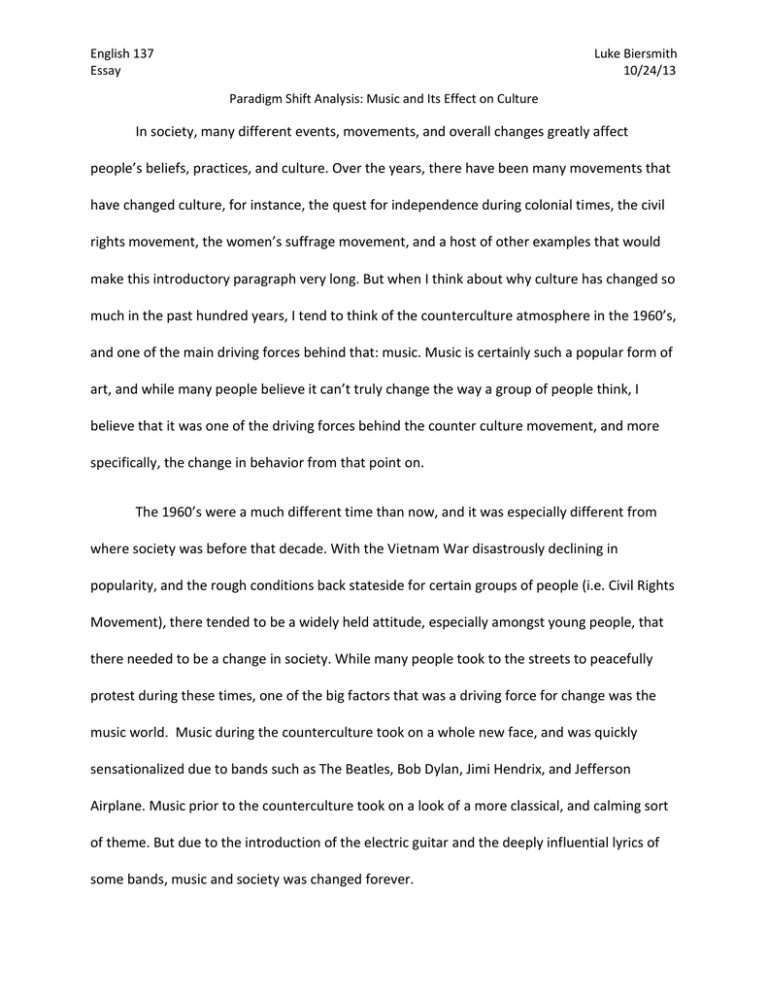
English 137 Essay Luke Biersmith 10/24/13 Paradigm Shift Analysis: Music and Its Effect on Culture In society, many different events, movements, and overall changes greatly affect people’s beliefs, practices, and culture. Over the years, there have been many movements that have changed culture, for instance, the quest for independence during colonial times, the civil rights movement, the women’s suffrage movement, and a host of other examples that would make this introductory paragraph very long. But when I think about why culture has changed so much in the past hundred years, I tend to think of the counterculture atmosphere in the 1960’s, and one of the main driving forces behind that: music. Music is certainly such a popular form of art, and while many people believe it can’t truly change the way a group of people think, I believe that it was one of the driving forces behind the counter culture movement, and more specifically, the change in behavior from that point on. The 1960’s were a much different time than now, and it was especially different from where society was before that decade. With the Vietnam War disastrously declining in popularity, and the rough conditions back stateside for certain groups of people (i.e. Civil Rights Movement), there tended to be a widely held attitude, especially amongst young people, that there needed to be a change in society. While many people took to the streets to peacefully protest during these times, one of the big factors that was a driving force for change was the music world. Music during the counterculture took on a whole new face, and was quickly sensationalized due to bands such as The Beatles, Bob Dylan, Jimi Hendrix, and Jefferson Airplane. Music prior to the counterculture took on a look of a more classical, and calming sort of theme. But due to the introduction of the electric guitar and the deeply influential lyrics of some bands, music and society was changed forever. English 137 Essay Luke Biersmith 10/24/13 The sixties witnessed intense upheaval. As Bob Dylan eloquently stated in 1964, “The times, they are a’ changing” (Dylan). The Vietnam War and the rights of women and minorities, the political turmoil of the 1968 presidential election, changing sexual attitudes, increased drug use, and radically different styles in clothes strained not only the country as a whole but also individual families. “Children and parents found themselves disagreeing over many areas of everyday life” (Batchelor, Introduction). Thus, a generation gap ensued; the “baby boomers” distanced themselves from their parents, and contributed to the growth of the emerging antiestablishment movement. The counter-culture, driven by the rebellious nature of its participants, was fueled by music. It was music that united those disgusted with the social aura of the fifties and the Vietnam War. Music exposed the distaste young people had with their government. It represented their social opinions and feelings. Music also embodied the psychedelic drug use that was a trademark of the counter-culture movement. It changed the social structure of the sixties in a way no one could have ever predicted. It was music that changed America. The fifties gave the world rock’n’roll. Buddy Holly, Chuck Berry, and Elvis Presley introduced rock’n’roll to the world, a genre dominated by teenage affections and a violent back beat. The genre originated in the 1940’s and 1950’s in the United States, though it soon crossed the Atlantic and dominated popular teenage culture in Britain. By the end of the fifties, however, “rock’n’roll lost some of its initial shock value” (Buskin). This would all change, especially in the United States. A group from a town called Liverpool in Britain, known as the Beatles, exploded onto the popular music scene in America with their arrival in the United States in 1964. Their appearance on the Ed Sullivan Show launched Beatlemania and the English 137 Essay Luke Biersmith 10/24/13 beginning of the, “British Invasion” (Pierce). The “British Invasion”, a term invented by radio announcers and journalists, was an era of British dominance on U.S. popular music charts. Artists such as the Rolling Stones, the Yardbirds, the Animals, Gerry and the Pacemakers, the Dave Clark Five, Herman’s Hermits, The Who, and the Kinks, “experienced unprecedented success in America, if not to the degree of the Beatles” (Pierce). The music industry transformed overnight, and suddenly the ever growing youth subculture dominated American culture. The seeds had been planted for a counter-culture to emerge, though the bands of the early sixties, such as the Beatles, were originally clean cut and well dressed. It was not until the mid to late sixties that the music created by these artists represented the counter-culture that created an irreparable divide between those who participated in the new movement and those who did not. While the “British Invasion” sparked interest in popular music to an unprecedented degree, folk music experienced a rebirth, “as musicians moved into the forefront of the Vietnam War and the civil rights protest movement” (Batchelor). The music created by folk artists represented the philosophy that would soon serve as the foundation for the counterculture movement. Folk artists such as Baez, Bob Dylan, Donovan, and Peter, Paul, and Mary crooned softly over melodic acoustic guitars and a soft, gentle back beat. Their lyrics were often poetic and laded with symbolism. Bob Dylan was widely regarded as a poet just as he was a singer and musician. His lyrics, “resonated with young, dissatisfied protesters of the war and other social aspects” (Batchelor). If the seeds for the emergence of a counter-culture had been planted by the rock’n’roll of the “British Invasion”, then folk artists watered the ground upon which the seed had been planted. English 137 Essay Luke Biersmith 10/24/13 Beginning in 1966, the psychedelic revolution had begun to unfold. Psychedelic music was inspired by the use of hallucinogenic drugs such as LSD, and was rooted in the counterculture movement. Psychedelic rock emerged as an entirely new musical genre, “glorifying drug use in its lyrics as its sonic distortions reflected altered perceptions” (Batchelor). Glorious, avant-garde arrangements appeared in songs such as the Beach Boys’ Good Vibrations and The Beatles’ A Day in the Life. The Beatles, “were to become the most prominent commercial exponents of the new genre with the release of the revolutionary album Sgt. Pepper’s Lonely Hearts Club Band in 1967” (Buskin). The album changed popular music forever, and the seed that had been planted had grown into an adult tree. The counter-culture had been born. San Francisco was the epicenter from which all things related to the counter-culture were born. LSD, the new wonder drug, “caught on among young teenagers living in San Francisco smitten with the folk rock boom happening in Los Angeles” (Buskin). In 1967, the San Francisco “sounds” popularized by groups such as The Grateful Dead, became the backdrop to the “Summer of Love”. The, “Summer of Love saw teenagers across the nation rejecting their parents’ values and joining together to grow their hair long and espouse brotherly love instead of supporting the expansionist war the United States was fighting in South-East Asia” (Buskin). “Hippies”, as these people became to be known, transformed American culture. The music of the sixties defined the counter-culture era, acting as its driving force and reflecting the principles behind the movement. Music became more than an expression and an escape. It became a way of life, a life driven by the use of drugs and resistance to the established order. Music contributed to the growth of the counter-culture; it offered solace to English 137 Essay Luke Biersmith 10/24/13 those disgusted with the Vietnam War and other social aspects of American culture. The music of the counter-culture era resonates with modern listeners, though in different form. It offers a glimpse into the lives of the “hippies” sleeping in the mud at Woodstock; into a trip induced by the use of LSD; into the life of an embattled poet struggling to express his disdain with the war in Vietnam. The music of the counter-culture era changed the social structure Americans lived in during the sixties, and it continues to influence artists of the modern age who are trying to do the same thing. English 137 Essay Luke Biersmith 10/24/13 Works Cited 1. Batchelor, Bob. “Introduction to the 1960s (Overview)”. Pop Culture Universe: Icons, Idols, Ideas. ABC-CLIO, 2011. 10/20/13 2. Buskin, Richard. “The Sixties”. The Definitive Illustrated Encyclopedia of Rock. World Publications Group, 2006. 10/20/13 3. Dylan, Bob. “The Times They Are A-Changing”. Recorded October 31, 1963. 10/21/13 4. Pierce, Lisa. “The British Invasion in Music and Fashion (Overview)”. Pop Culture Universe: Icons, Idols, Ideas. ABC-CLIO, 2011. 10/22/13.
